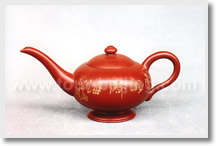Chinese Tea
Teapot Brewing – Chinese Folklore
This is a tradition of the Minnan people and Chaozhou or Chaoshan people have made this Kungfu cha famous. Kungfu cha teapot brewing uses small Yixing purple clay teapot to “round out” the taste of the tea being brewed.

1. Boil water
2. Rinse the teapot with hot water
3. Fill the teapot with tea leaves up to one third of the height of the pot.
4. Rinse the tea leaves by filling the pot with hot water up to half full and draining the water immediately leaving only tea leaves behind.
5. Pour more hot water into the teapot and pour water over the teapot in the large bowl. Bubbles should not be permitted to be formed in the teapot. The infusion should not be steeped for too long: 30 seconds is an appropriate maximum.
6. Pour the first infusion into small serving cups within a minute by continuously moving the teapot around over the cups. Each cup of the tea is expected to have the some flavor and color.
7. Pour excess tea from the first infusion, and all tea from further infusions, into a second teapot after steeping.
Brewing Chinese Tea – Chinese Folklore
There are many different ways of brewing Chinese tea depending on variables like formality of the occasion, the means of the people preparing it and the kind of tea being brewed. For example, green teas are delicate than oolong teas or black tea and should be brewed with cooler water as a result.
Chaou brewing
The Chaou is a three piece teaware consisting of a lid, cup/bowl, and a soucer, which can be used on its own or with tasting cups on the side. Chaou brewing is usually employed in tea tasting situations, such as when buying tea, where neutrality in tate and ease of access to brewing leaves for viewing and sniffing is important.
Chaou Brewing can be used for ail forms of teas though lightly axidized teas benefit most from this brewing method.
Boil water, or heat to specified temperature for tea, which is 80℃ for oolong tea.
Heat chaou with oiling water.
Add leaves to line bottom of chaou.
Rinse tea leaves and drain
Slip water along the side while pouring into cup to 2/3 full.
Wait for 30 seconds, pour the tea.
serve
Tea wares – Chinese Folklore
Tea wares consist of ovens, teapots, cups, tea bowls, and trays and so on. Nowadays, with the development of tea procedure, we can make a cup of tea with a single porcelain cup. In the following paragraphs, we will focus on the most essential tea ware-tea cups and teapots.
The customs of drinking tea propelled the development of the porcelain industry. Tang scholars preferred green porcelain from Shaoxing, Zhejiang province. As to function, the size and design of the cup best suited to the tea drinking habit of that time allowed for cooking tea powder with green onion, ginger, dates, tangerine peels and mint, then drinking the whole soup.
The preference for green porcelain or white porcelain was suddenly changed to black glazed teacups in the Song Dynasty. Scholars emphasized the white foam that formed when boiled water was added to the teacup. The most desirable foam was white, best presented in black tea ware. Black glazed tea ware from Fujian was dominant, while purple clay tea wares emerged in Yixing, Jiangsu.
In the beginning of the Ming Dynasty, tea was made by pouring boiled water onto loose tea leaves. The tea liquor turned yellowish white, so snow-white teacups replaced the black-glazed tea ware of the Song Dynasty. In the middle of the Ming, with the advent of purple clay tea ware, focus was not limited to the color contrast of tea liquor and tea ware, but switched to the fragrance and taste of tea. The production of various teapots came to its pinnacle at the time.
Tea wares made for the royal family in Jingdezhen, Jiangxi, shone brilliantly among numerous tea wares. New designs of teapots and cups increased continually with the development of tea types.
Tea drinking customs – Chinese Folklore
There are several special circumstances in which tea is prepared and consumed.
To show respect: In Chinese society, the younger generation always show its respect to the older generations by offering a cup of tea. Inviting and paying for their elders to go to restaurants for tea is a traditional activity on holidays.
In the past, people of lower rank served tea to higher ranking people. Today, as Chinese society becomes more liberal, sometimes at home parents may pour a cup of tea for their children, or a boss may even pour tea for subordinates at restaurants. The lower ranking person should not expect the higher rank person to serve him or her tea on formal occasions, however.
For a family gathering: When sons and daughters leave home to work and get married, they may seldom visit their parents. As a result, parents may seldom meet their grandchildren. Going to restaurants and drinking tea, therefore, becomes an important activity for family gatherings. Every Sunday, Chinese restaurants rants are crowded, especially when people celebrate festivals. This phenomenon reflects Chinese family values.
To apologize: In Chinese culture, people make serious apologize to others by pouring tea on them. That is a sign of regret and submission.
To express thanks to your elders on one’s wedding day: At the traditional Chinese marriage ceremony, both the bride and groom kneel in front of their parents and serve them tea. That is a way to express their gratitude. In front of their parents, it is a practice for the married couple to say: “thanks for bringing us up. Now we are getting marriage. We owe it all to you.” The parents will usually drink a small portion of the tea and then give them a red envelope, which symbolizes good luck.
Questions & Answers:



